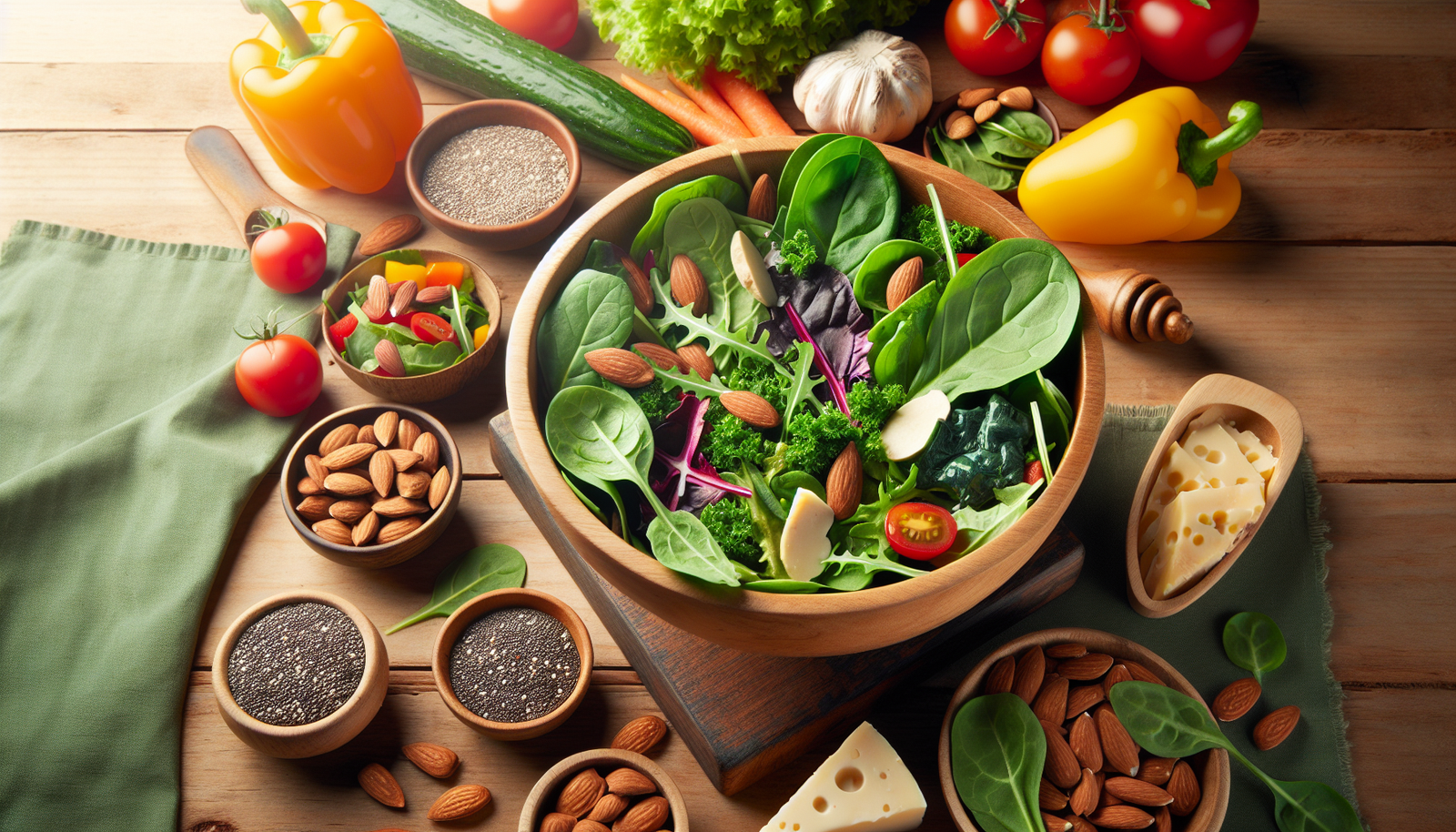
How to Incorporate Leafy Greens for Better Bone Health
Leafy greens for bone health are vital due to their high calcium and vitamin K content. Did you know that just one cup of kale can provide almost twice the daily recommended intake of vitamin K? This article explores how incorporating leafy greens like spinach, kale, and collard greens into your diet can significantly improve bone health. We’ll dive into the nutrient profiles of these vegetables and practical ways to include them in your meals. Understanding these benefits can motivate you to make better dietary choices, ensuring stronger bones for life.
Benefits of Leafy Greens for Bone Health
Leafy greens are often hailed as nutritional champions, and their benefits extend beyond basic health. They play a significant role in promoting strong bones, offering a wide range of essential nutrients crucial for bone maintenance and growth. Incorporating these greens into your diet can be a delicious way to support bone health and reduce the risk of osteoporosis. Let’s explore the benefits in detail.
Essential Nutrients Found in Leafy Greens
Leafy greens are packed with nutrients that are essential for bone health. These include:
- Calcium: Crucial for bone density and strength.
- Vitamin K: Important for bone metabolism and helps in the binding of calcium to the bone matrix.
- Magnesium: Facilitates calcium absorption and is involved in bone formation.
- Potassium: Helps to neutralize bone-depleting acids, maintaining bone mineral density.
- Folate: Plays a role in bone health by reducing homocysteine levels, which can weaken bones.
These nutrients are found in abundance in leafy greens, making them a vital part of a bone-healthy diet.
How Leafy Greens Support Strong Bones
Leafy greens contribute to strong bones through various mechanisms. Calcium and vitamin K are directly involved in building and maintaining bone structure. Calcium provides the raw material for bone formation, while vitamin K activates proteins that bind calcium within the bone. Magnesium supports this process by aiding in calcium absorption and conversion into the bone matrix.
Potassium helps to balance the body’s pH levels, reducing the loss of calcium in urine and preventing bone weakening. Folate reduces levels of homocysteine, an amino acid that, in high levels, can lead to bone fragility. The combination of these nutrients in leafy greens not only helps in building strong bones but also in maintaining them as we age.
Research Backing Leafy Greens for Osteoporosis Prevention
Scientific research underscores the importance of leafy greens in preventing osteoporosis. Studies have shown that individuals with higher intakes of vitamin K have better bone density and a reduced risk of fractures. Calcium-rich diets, including leafy greens, are associated with improved bone health and a lower incidence of osteoporosis.
Research also highlights the role of magnesium in bone health, with dietary deficiencies linked to increased bone fragility. Potassium’s ability to neutralize acids that cause bone degradation further supports the case for leafy greens as a preventative measure against osteoporosis. By incorporating a variety of leafy greens into your diet, you can harness these benefits to protect and strengthen your bones.
Top Leafy Greens to Improve Bone Health
Exploring specific leafy greens can help you target bone health more effectively. Some greens stand out due to their exceptional nutrient profiles, offering more concentrated benefits for bone health. Here’s a closer look at the top leafy greens that can play a pivotal role in enhancing bone strength and preventing bone-related conditions.
Kale: A Nutrient Powerhouse for Bones
Kale is often referred to as a superfood, and for good reason. It’s packed with nutrients that are essential for bone health:
- High in Calcium: Kale offers a substantial amount of calcium, which is crucial for bone density.
- Rich in Vitamin K: Supports calcium binding in bones, enhancing bone strength.
- Contains Magnesium and Potassium: These support calcium absorption and balance, further fortifying bones.
Kale’s nutrient density makes it an excellent choice for anyone looking to improve their bone health. It can be added to salads, smoothies, or cooked dishes, allowing for versatile culinary use.
Spinach: Rich in Calcium and Vitamin K
Spinach is another leafy green that is a staple for bone health, offering:
- Abundant Calcium: Promotes bone strength and density.
- High Vitamin K Content: Essential for bone metabolism and calcium absorption.
- Magnesium and Folate: Further support bone health by aiding in calcium utilization and reducing homocysteine levels.
Spinach is easy to incorporate into your diet, whether as a salad base, in omelets, or blended into a smoothie. Its mild flavor makes it a versatile ingredient in various dishes.
Collard Greens: Supporting Bone Strength
Collard greens are often overlooked but are a great source of nutrients for bone health:
- Calcium-Rich: Essential for maintaining strong bones.
- Packed with Vitamin K: Helps with bone mineralization and strength.
- Contains Potassium and Magnesium: These help maintain bone density and improve calcium absorption.
Collard greens can be enjoyed in traditional dishes or modern recipes, providing a robust flavor and a wealth of benefits for your bone health.
Tips for Incorporating Leafy Greens into Your Diet
Incorporating more leafy greens into your diet doesn’t have to be challenging. With a bit of creativity and planning, you can enjoy these nutritious greens in a variety of delicious ways. Whether through innovative recipes, simple meal additions, or refreshing smoothies, leafy greens can easily become a staple in your daily diet.
Delicious Recipes Featuring Leafy Greens
Leafy greens can be the star of many delightful dishes. Here are some ideas to get you started:
- Kale and Quinoa Salad: Mix kale, cooked quinoa, cherry tomatoes, and feta cheese. Drizzle with lemon vinaigrette for a refreshing meal.
- Spinach and Feta Stuffed Chicken: Fill chicken breasts with spinach and feta cheese. Bake until golden for a nutritious dinner.
- Collard Green Wraps: Use collard leaves as a healthy alternative to wraps, filled with grilled veggies or your choice of protein.
These recipes not only boost your intake of leafy greens but also add a variety of flavors to your meals.
Easy Ways to Add Leafy Greens to Every Meal
Making leafy greens a regular part of your diet can be simple with these tips:
- Breakfast: Add a handful of spinach to your morning smoothie or scramble eggs with kale for a nutrient-packed start.
- Lunch: Toss a variety of leafy greens into your sandwich or wrap for added crunch and nutrition.
- Dinner: Incorporate collard greens into soups or stews, or use them as a side dish to complement your main course.
These small changes ensure you’re consistently consuming leafy greens, maximizing their benefits for bone health.
Creative Smoothie Ideas with Leafy Greens
Smoothies are an easy and tasty way to consume more leafy greens. Try these combinations:
- Green Power Smoothie: Blend kale, banana, almond milk, and a scoop of protein powder for a nutrient-dense start to your day.
- Berry Spinach Blast: Mix spinach, mixed berries, Greek yogurt, and a splash of orange juice for a refreshing drink.
- Citrus Collard Cooler: Blend collard greens with pineapple, lime juice, and coconut water for a tropical twist.
These smoothie ideas make it easy to enjoy the benefits of leafy greens without compromising on taste.
Conclusion
Leafy greens are beneficial for bone health due to their high calcium content. They are a rich source of vitamin K, which is crucial for bone mineralization. Greens like kale and spinach also provide magnesium, supporting bone density. Consuming leafy greens regularly can help prevent osteoporosis. They contribute to overall bone strength and health.
FAQ
What are the best leafy greens for improving bone health?
Spinach, kale, and collard greens excel in promoting bone health. These greens pack a punch with calcium, vitamin K, and magnesium, essential for bone strength.
How do leafy greens contribute to stronger bones?
Leafy greens provide key nutrients like calcium and vitamin K. These nutrients aid in maintaining bone density and supporting overall skeletal health.
Can consuming leafy greens prevent bone-related diseases?
Incorporating leafy greens into your diet can lower the risk of bone-related diseases, such as osteoporosis. Their rich nutrient profile fortifies bones and enhances bone mineral density.
How often should I eat leafy greens to support bone density?
Eating leafy greens at least 3-4 times a week supports bone density. Regular consumption ensures a steady supply of essential nutrients needed for bone maintenance.
Are there specific nutrients in leafy greens that benefit bone health?
Calcium, vitamin K, and magnesium in leafy greens directly benefit bone health. These nutrients play crucial roles in bone formation and maintaining bone structure.
Which leafy greens are highest in calcium for bone strength?
Collard greens and kale top the list for calcium content. Including these in your diet can significantly boost calcium intake for stronger bones.











